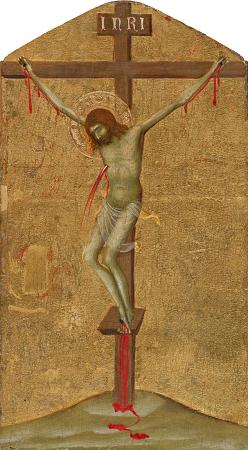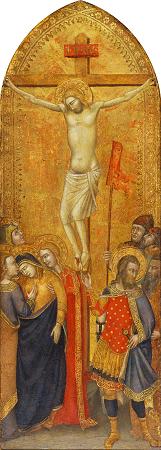Crucifixion of Christ. The crucifixion of Jesus occurred in 1st-century Judea, most likely between AD 30 and 33. Jesus' crucifixion is described in the four canonical gospels, referred to in the New Testament epistles, attested to by other ancient sources, and is established as a historical event confirmed by non-Christian sources, although there is no consensus among historians on the exact details. According to the canonical gospels, Jesus was arrested and tried by the Sanhedrin, and then sentenced by Pontius Pilate to be scourged, and finally crucified by the Romans. Jesus was stripped of his clothing and offered wine mixed with myrrh or gall to drink after saying I am thirsty. He was then hung between two convicted thieves and, according to the Gospel of Mark, died some six hours later. During this time, the soldiers affixed a sign to the top of the cross stating Jesus of Nazareth, King of the Jews which, according to the Gospel of John, was written in three languages. They then divided his garments among themselves and cast lots for his seamless robe, according to the Gospel of John. According to the Gospel of John after Jesus' death, one soldier pierced his side with a spear to be certain that he had died, then blood and water gushed from the wound. The Bible describes seven statements that Jesus made while he was on the cross, as well as several supernatural events that occurred. Collectively referred to as the Passion, Jesus' suffering and redemptive death by crucifixion are the central aspects of Christian theology concerning the doctrines of salvation and atonement. The baptism of Jesus and his crucifixion are considered to be two historically certain facts about Jesus. James Dunn states that these two facts in the life of Jesus command almost universal assent and rank so high on the 'almost impossible to doubt or deny' scale of historical facts that they are often the starting points for the study of the historical Jesus. Bart Ehrman states that the crucifixion of Jesus on the orders of Pontius Pilate is the most certain element about him. John Dominic Crossan states that the crucifixion of Jesus is as certain as any historical fact can be. Eddy and Boyd state that it is now firmly established that there is non-Christian confirmation of the crucifixion of Jesus. Craig Blomberg states that most scholars in the third quest for the historical Jesus consider the crucifixion indisputable. Christopher M. Tuckett states that, although the exact reasons for the death of Jesus are hard to determine, one of the indisputable facts about him is that he was crucified. While scholars agree on the historicity of the crucifixion, they differ on the reason and context for it. For example, both E. P. Sanders and Paula Fredriksen support the historicity of the crucifixion but contend that Jesus did not foretell his own crucifixion and that his prediction of the crucifixion is a church creation. Geza Vermes also views the crucifixion as a historical event but provides his own explanation and background for it. John P. Meier views the crucifixion of Jesus as historical fact and states that Christians would not have invented the painful death of their leader, invoking the criterion of embarrassment principle in historical research. Meier states that a number of other criteria, e.g., the criterion of multiple attestation and the criterion of coherence help establish the crucifixion of Jesus as a historical event. Although almost all ancient sources relating to crucifixion are literary, the 1968 archeological discovery just northeast of Jerusalem of the body of a crucified man dated to the 1st century provided good confirmatory evidence that crucifixions occurred during the Roman period roughly according to the manner in which the crucifixion of Jesus is described in the gospels. The crucified man was identified as Yehohanan ben Hagkol and probably died about 70 AD, around the time of the Jewish revolt against Rome. The analyses at the Hadassah Medical School estimated that he died in his late 20s. Another relevant archaeological find, which also dates to the 1st century AD, is an unidentified heel bone with a spike discovered in a Jerusalem gravesite, now held by the Israel Antiquities Authority and displayed in the Israel Museum. The earliest detailed accounts of the death of Jesus are contained in the four canonical gospels. There are other, more implicit references in the New Testament epistles. In the synoptic gospels, Jesus predicts his death in three separate places.
more...














